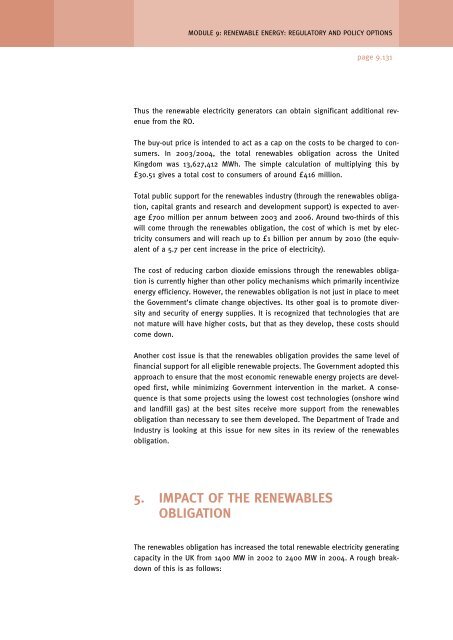Regulatory and policy options to encourage development of ...
Regulatory and policy options to encourage development of ...
Regulatory and policy options to encourage development of ...
- No tags were found...
Create successful ePaper yourself
Turn your PDF publications into a flip-book with our unique Google optimized e-Paper software.
MODULE 9: RENEWABLE ENERGY: REGULATORY AND POLICY OPTIONSpage 9.131Thus the renewable electricity genera<strong>to</strong>rs can obtain significant additional revenuefrom the RO.The buy-out price is intended <strong>to</strong> act as a cap on the costs <strong>to</strong> be charged <strong>to</strong> consumers.In 2003/2004, the <strong>to</strong>tal renewables obligation across the UnitedKingdom was 13,627,412 MWh. The simple calculation <strong>of</strong> multiplying this by£30.51 gives a <strong>to</strong>tal cost <strong>to</strong> consumers <strong>of</strong> around £416 million.Total public support for the renewables industry (through the renewables obligation,capital grants <strong>and</strong> research <strong>and</strong> <strong>development</strong> support) is expected <strong>to</strong> average£700 million per annum between 2003 <strong>and</strong> 2006. Around two-thirds <strong>of</strong> thiswill come through the renewables obligation, the cost <strong>of</strong> which is met by electricityconsumers <strong>and</strong> will reach up <strong>to</strong> £1 billion per annum by 2010 (the equivalen<strong>to</strong>f a 5.7 per cent increase in the price <strong>of</strong> electricity).The cost <strong>of</strong> reducing carbon dioxide emissions through the renewables obligationis currently higher than other <strong>policy</strong> mechanisms which primarily incentivizeenergy efficiency. However, the renewables obligation is not just in place <strong>to</strong> meetthe Government’s climate change objectives. Its other goal is <strong>to</strong> promote diversity<strong>and</strong> security <strong>of</strong> energy supplies. It is recognized that technologies that arenot mature will have higher costs, but that as they develop, these costs shouldcome down.Another cost issue is that the renewables obligation provides the same level <strong>of</strong>financial support for all eligible renewable projects. The Government adopted thisapproach <strong>to</strong> ensure that the most economic renewable energy projects are developedfirst, while minimizing Government intervention in the market. A consequenceis that some projects using the lowest cost technologies (onshore wind<strong>and</strong> l<strong>and</strong>fill gas) at the best sites receive more support from the renewablesobligation than necessary <strong>to</strong> see them developed. The Department <strong>of</strong> Trade <strong>and</strong>Industry is looking at this issue for new sites in its review <strong>of</strong> the renewablesobligation.5. IMPACT OF THE RENEWABLESOBLIGATIONThe renewables obligation has increased the <strong>to</strong>tal renewable electricity generatingcapacity in the UK from 1400 MW in 2002 <strong>to</strong> 2400 MW in 2004. A rough breakdown<strong>of</strong> this is as follows:










